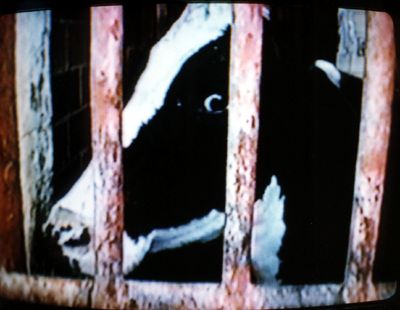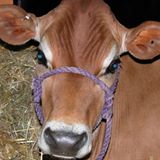BEEF CATTLE

Since the 1980's a series of mergers and acquisitions has
resulted in concentrating over 80% of the 35 million beef cattle
slaughtered annually in the U.S. into the hands of four huge
corporations.
Many beef cattle are born and/or live on the range, foraging and fending for
themselves, for months or even years. They are not adequately protected
against inclement weather, and they may die of dehydration or freeze to
death. Injured, ill, or otherwise ailing animals do not receive necessary
veterinary attention. One common malady afflicting beef cattle is called
"cancer eye." Left untreated, the cancer eats away at the animal's eye and
face, eventually producing a crater in the side of the animal's head.
Accustomed to roaming unimpeded and unconstrained, range cattle are
frightened and confused when humans come to round them up. Injuries often
result as terrified animals are corralled and packed onto cattle trucks.
Many will experience additional transportation and handling stress at stock
yards and auctions where they are goaded through a series of walkways and
holding pens and sold to the highest bidder. From the auction, older cattle
may be taken directly to slaughter, or they may be taken to a feedlot.
Younger animals, and breeding age cows, may go back to the range.
Ranchers still identify cattle the same way they have since pioneer days,
with hot iron brands. Needless to say, this practice is extremely traumatic
and painful, and the animals bellow loudly as ranchers' brands are burned
into their skin. Beef cattle are also subjected to waddling, another type of
identification marking. This painful procedure entails cutting chunks out of
the hide which hangs under the animals' necks. Waddling marks are supposed
to be large enough so that ranchers can identify their cattle from a
distance.
Most beef cattle spend the last few months of their lives at feedlots,
crowded by the thousand into dusty, manure laden holding pens. The air is
thick with harmful bacteria and particulate matter, and the animals are at a
constant risk for respiratory disease. Feedlot cattle are routinely
implanted with growth promoting hormones, and they are fed unnaturally rich
diets designed to fatten them quickly and profitably. Because cattle are
biologically suited to eat a grass-based, high fiber diet, their
concentrated feedlot rations contribute to metabolic disorders.
Cattle may be transported several times during their lifetimes, and they may
travel hundreds or even thousands of miles during a single trip. Long
journeys are very stressful and contribute to disease. The Drover's Journal
reports, "Shipping fever costs livestock producers as much as $1 billion a
year."
Young cattle are commonly taken to areas with cheap grazing land, to take
advantage of this inexpensive feed source. Upon reaching maturity, they are
trucked to a feedlot to be fattened and readied for slaughter. Eventually,
all of them will end up at the slaughterhouse.
At a standard beef slaughterhouse, 250 cattle are killed every hour. As the
assembly line speeds up, workers are rushed, and it becomes increasingly
difficult to treat animals with any semblance of humaneness. A Meat &
Poultry article states, "Good handling is extremely difficult if equipment
is 'maxed out' all the time. It is impossible to have a good attitude toward
cattle if employees have to constantly over exert themselves, and thus
transfer all that stress right down to the animals, just to keep up with the
line."
Prior to being hung up by their back legs and bled to death, cattle are
supposed to be rendered unconscious. This 'stunning' is usually done by a
mechanical blow to the head. The procedure is terribly imprecise, and
inadequate stunning is inevitable. The result of poor stunning is conscious
animals hanging upside down, kicking and struggling, while a slaughterhouse
worker makes another attempt to render them unconscious. Eventually, the
animals will be "stuck" in the throat with a knife, and blood will gush from
their bodies whether or not they are unconscious.

